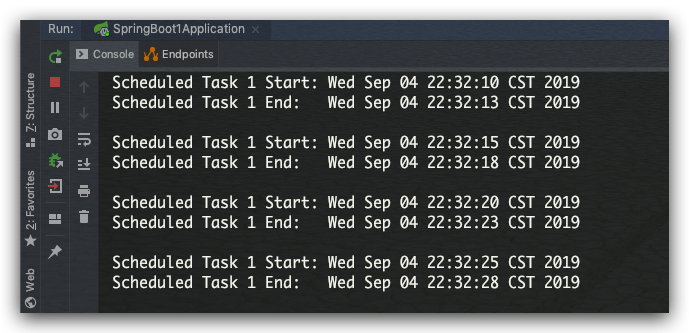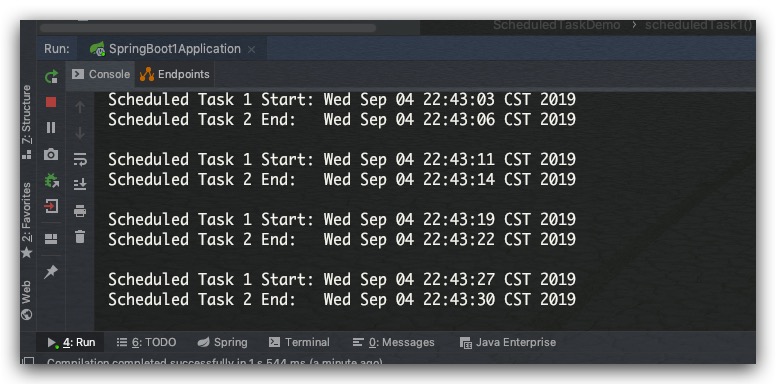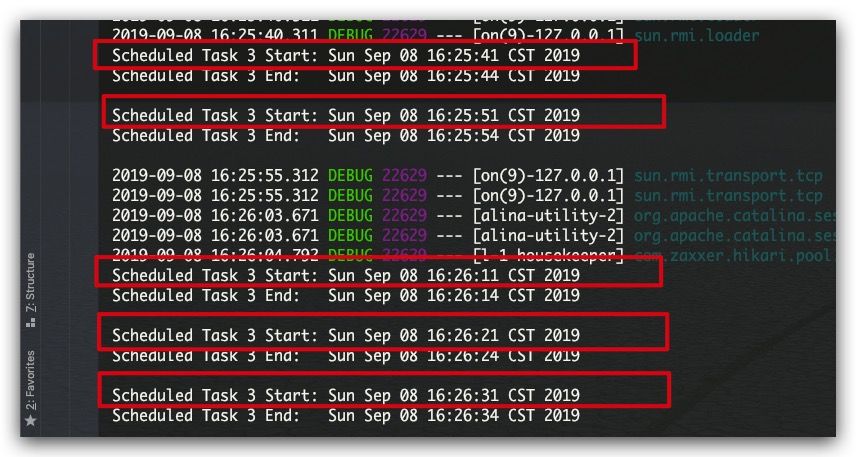Java下的定时任务实现有Timer,Spring,QuartZ等,这里我们介绍Spring中定时任务的应用,其通过 @Scheduled 注解即可轻松实现

概述
Spring 的定时任务可以支持各种形式的定时调度任务。其通过加在定时方法上的 @Scheduled 注解来配置任务执行周期,还需要在SpringBoot1Application启动类上添加 @EnableScheduling 注解来使能定时任务(如下所示),否则定时任务将无法执行
1 |
|
@Scheduled(fixedRate = msNum )
fixedRate 指定定时任务开始调用的时间间隔(单位为ms),示例如下所示:定时任务每5s调用一次
1 |
|
从下图的调用结果可以看出,定时任务如我们所配置的那样,每5秒调用一次:

@Scheduled(fixedDelay = msNum)
fixedDelay 指定定时任务从本次调用结束到下一次开始调用的时间间隔(单位为ms),示例如下所示:
1 |
|
定时任务在结束5秒后即开始下一次调用:

cron表达式
Spring的@Scheduled注解同时也支持cron表达式,实现更复杂的定时配置。其由6个字段组成,使用空格进行分隔
- 秒: 取值范围: 0~59
- 分: 取值范围: 0~59
- 时: 取值范围: 0~23
- 日: 取值范围: 1~31
- 月: 取值范围: 1~12,JAN~DEC(大小写不敏感)
- 星期: 取值范围: 0~7(0为周日,1为周一,…,7为周日),SUN~SAT(大小写不敏感)
取值表示方法
- , : 表示该字段多个有效值。即,当’秒’字段为10,30,50,表示秒为10、30、50时生效
- init/step : init为该字段的有效初值,step为步长。即,当’秒’字段为10/20时,表示秒为10、30(10+20)、50(30+20)时生效,其等同于10,30,50
- - : 表示该字段均有效的取值范围。即,当’月’字段为1-3,表示月为1、2、3时生效
- * : 表示该字段的所有值均有效。即,当’月’字段为 * ,表示每个月均生效
- ? : 表示该字段无效,只能应用在日和星期字段。由于日和星期字段同时使用会发生冲突,故只能使用一个生效,另一个则使用 ?
cron表达式示例:
13/30 0,3 * * * ? : 每小时的0分13秒、0分43秒、3分13秒、3分43秒
34 2 3-5 * * ? : 每天的3点2分34秒、4点2分34秒、3点2分34秒
0 0 3 4 5 ? : 每年5月4日的3点0分0秒
0 0 3 ? * 6 : 每月周六的3点0分0秒
测试用例
1 |
|
定时任务在每天的16~20点的11、21、31、41、51秒执行:

与WebSocket集成问题
之前在我的项目中,已经添加WebSocket功能,然后按照上面的配置定时任务后,会启动失败,抛出如下异常:
org.springframework.beans.factory.BeanNotOfRequiredTypeException: Bean named ‘defaultSockJsTaskScheduler’ is expected to be of type ‘org.springframework.scheduling. TaskScheduler’ but was actually of type ‘org.springframework.beans.factory.support.NullBean’
解决方案:
我们需要手动添加一个Scheduled的配置类来创建一个ThreadPoolTaskScheduler对象,此时项目即可成功启动
1 |
|
